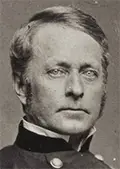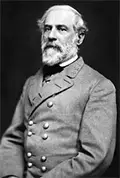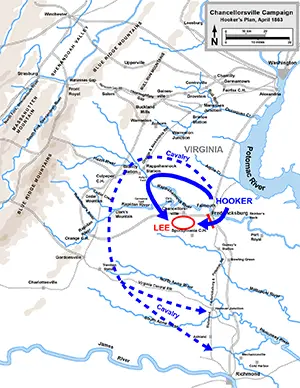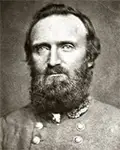The Battle of Chancellorsville
The Battle of Chancellorsville was a spectacular tactical success for the Confederacy during the American Civil War. Casualties for both sides were about equal, however. 

After the disastrous Union defeat at Fredericksburg, the Army of the Potomac had a new commander, Maj. Gen. Joseph Hooker (left). Known as "Fighting Joe," Hooker had proved himself an aggressive battle commander, the opposite of his two predecessors, Ambrose Burnside and George McClellan. Hooker spent the spring of 1863 shoring up his force, giving wounded soldiers time to heal and starving soldiers time to replenish their strength. President Abraham Lincoln, Secretary of War Edwin Stanton, and the rest of the Union command still wanted the Army of the Potomac to capture Richmond, the capital of the Confederacy. Hooker devised a plan to do this. He also took the first few months of the third year of the Civil War to create and outfit an independent cavalry group, to be led by Maj. Gen. George Stoneman. Meanwhile, in Fredericksburg, the Army of Northern Virginia struggled to maintain supplies. In desperation, Gen. Robert E. Lee (above, right) dispatched Maj. Gen. John Bell Hood, Maj. Gen. George Pickett, and a large number of troops to range southward in search of supplies. While they were in the field, Hooker's army outnumbered Lee's army 2–1. 
Hooker knew the state of play and employed his strategy. He hoped to catch the Confederate forces unaware by having Union troops cross the Rappahannock River (over which Burnside had led his troops in retreat after the Battle of Fredericksburg) further upstream and then fall on the Confederate army from the rear. To that end, Stoneman and 10,000 men went to Sulphur Spring on April 13; they could not cross the river because of heavy rains. Undaunted, Hooker ordered Stoneman to make another attempt and chose another place for another force to cross the river, at Kelly's Ford. A total of 42,000 made that crossing. A further 40,000 troops led by Maj. Gen. John Sedgwick were to cross the river south of Fredericksburg and hit the Confederate right flank. Hooker's attempt at concealment was to have 25,000 men stay right where they were, appearing as though they were still resting up from the cold hard winter. As for the newly created cavalry corps, Stoneman and his men were to tear into the Confederate supply lines, ripping up railroad tracks from Richmond and otherwise preventing reinforcements from reaching Lee and his men. The troops crossed the river successfully at both points, on April 27 and April 30. As a result, the Union force at Chancellorsville numbered 70,000. Not for the first or last time, Lee divided his outnumbered force and, even though heavily outnumbered, ordered his men to attack. 
Despite his reputation for taking the initiative, Hooker chose to dig in at Chancellorsville, trusting in his troops' defensive capabilities. (His commanders had urged him to at least take the nearby high ground, but Hooker demurred.) The one part of the Union army as positioned at Chancellorsville that wasn't as strong as the others was the right flank. It was this point that Gen. Stonewall Jackson and his men had reached in the early evening on May 2, by stealing through a woods that concealed their movements. The Confederate attack coincided with mealtime in the Union camp, and the result was a hammer blow for Jackson's troops, including 4,000 captured Union soldiers. The right flank fell back, and confusion reigned in the Union ranks. They did not retreat, however; a brief Union counterattack forced a lull in the fighting. 
Later that night, Jackson (right) wanted to know whether a nighttime attack would work, so he and a few of his troops rode out to have a look. When they returned, a handful of Confederate soldiers thought that they were the enemy and opened fire. Jackson sustained three bullet wounds and ended up having his left arm amputated. As happened so often during this time in history, an infection accompanied the operation, and Jackson died, on May 10. Hooker, too, sustained an injury due to enemy fire, on May 3. He refused to leave the field of battle, and the two sides continued to press each other. Lee, again the aggressor, sent a force from Fredericksburg that ended up shoving Sedgwick's men back across the river. On that same day, May 5, Hooker became convinced that he couldn't win and so ordered a full-scale retreat. As per the rules of warfare, the Battle of Chancellorsville was a Confederate victory because the enemy left the field of battle. However, casualty figures for both sides were roughly equal: Confederate dead totaled 1,665, injured totaled 9,081, and missing or captured totaled 2,018; Union numbers for the same categories were 1,606 dead, 9,762 injured, and 5,919 missing or captured. |
|
Social Studies for Kids
copyright 2002–2024
David White




